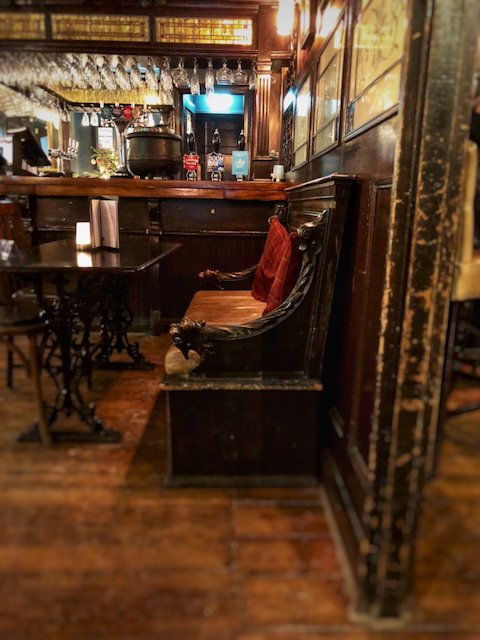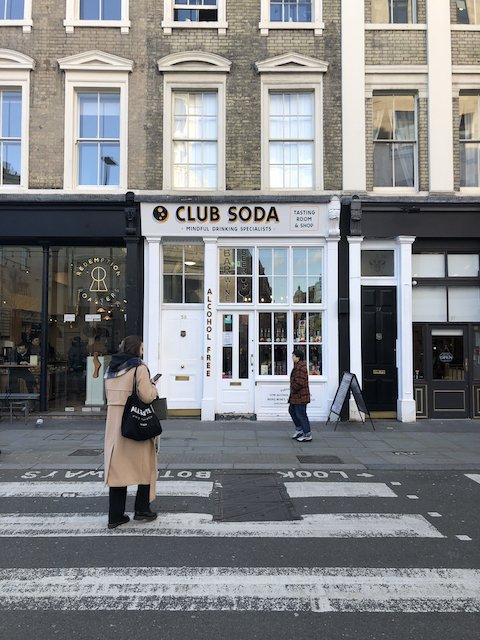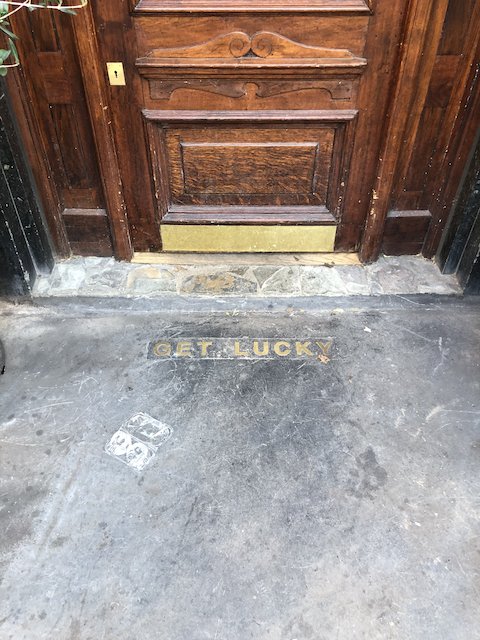January: Is This A Golden Age For London Pubs?
Not a subscriber? Sign up here
Perfect Pubs
When it comes to pubs, the news is invariably bad. They’ve been fighting a forlorn rearguard action for decades, battered by governmental indifference - at best - and preyed upon by opportunistic developers. Dozens have closed: a 2017 report by Lewisham Council, for example, discovered that half of the borough’s pubs were no more, most of them having given up the ghost in the previous 20 years.
I can easily compile a list of pubs that live on only in memory. The Kentish backstreet boozer decorated with pictures of dogs playing pool, and with just three beers on the bar, all multinational lagers; the barn-like Birmingham student pub where a friend once indignantly protested his ejection for dancing on the table with the words, “You can’t bar me, I’m already barred” (he’d been kicked out two weeks earlier for the same infraction); the South London hole-in-the-wall where I drank Brooklyn Lager, at the time - about 20 years’ ago - a tantalising taste of the beer-world to come.
Given the current economic pressures, it’s worse now than ever. But pubs closing is not a phenomenon just of the last 20 years; they’ve been shutting since the Victorian era, as Mark Girouard pointed out in his superb 1975 book Victorian Pubs. “London is full of dead pubs,” he wrote back then; “In Oxford Street between St Giles Circus and Marble Arch there were 19 pubs in 1890; today there is only one.” (That pub, then the Tottenham and now The Flying Horse, is still there, btw: it’s worth a visit for its classic 1890s interior).
You cannot discuss the decline of pubs without acknowledging the huge changes in society that have taken place, and the new and varied options open to ordinary people that didn’t exist in 1890 or even 1980 (the pre-cheeky Nando’s era, if you like). So much of the hand-wringing over pubs is really disgruntlement at how society has changed - which is all very well, depending on your perspective, but it doesn’t get us very far.
But amid this gloom something interesting has happened: I think London’s best pubs are as good as I’ve ever seen them. Covid-19 has done a lot of funny things to London hospitality - not least Heineken’s increasingly iron free-trade grip, a grip currently manifesting itself in a mini-Murphy’s revival - but one is the impact it’s had on our attitude to pubs. We missed them, and, as a recent Evening Standard list demonstrates, we’re keener than ever to celebrate the best ones - where hospitality, warmth, a sense of historical continuity and an unfussy approach to good drinks are the norm. After Covid, drinkers understand better this is what makes a good pub.
Even service, that persistent bane of the London pub-goer, appears to have improved in our best pubs. Martin Taylor, pub-goer extraordinaire, wrote in December that “Pubbing in London is brilliant, and I can honestly say both the beer quality and the friendliness have got better since Covid.”
I was intrigued so I asked him to elaborate. “Historically, I’d always said that beer quality in most of London - the West, particularly - was often below Good Beer Guide standards,” he told me. “The service was always rushed.
“Covid saw City pubs re-open with less midweek trade but a lot more time to chat to a lone drinker, and that cheeriness has continued even as trade has crept back; [you] rarely get a surly or disinterested young staff member anywhere. The Sutton Arms in Clerkenwell, the Ship in Tower Hill and of course the Shirker's Rest [in New Cross] [have been] particularly cheery.”
It’s telling that perhaps the biggest opening of this winter was a pub, The Devonshire in Soho (alright, there’s a restaurant upstairs, but it’s still essentially a pub). When was the last time a pub outshone London’s diverse and diverting restaurant scene like this? 1898, probably - which may also be the last time a pub approached the business of promotion and delivery with the sort of swagger that has characterised The Devonshire since it opened its doors in November.
Landlord Oisin Rogers, perhaps unsurprisingly, is positive about the future of London pubs. “I’ve lived my life in pubs - I’ve worked in them since I was 18 and I’m 56 now,” he says. “While I might be seen as a dinosaur in some ways, I feel that the future of great pubs is really bright, and will continue to be. Those of us that innovate and do things really well, and make sure that our guests feel safe, happy, well looked-after, excited, positive, [and] they feel like the money they’ve spent has led to more than just a great beer [will succeed]. Pubs are magic.”
Of course, there are issues. Issues will always be with us! Cask-ale choice is dropping overall, and the city has far too many bland chain pubs. But even there things are improving: Shepherd Neame, for example, is investing hugely in its London stable, for example, so even if you don’t like the beer (Bishops Finger is delicious, though), you’ll enjoy the experience.
London’s best pubs are now cleaner, friendlier, and with beer in better condition than at any point during the 20 years I’ve lived in London. You can debate the causes - Covid-19, better general understanding about how beer should taste/look (Shit London Guinness has definitely helped), the quality of modern landlords/managers, the pressure pubs are currently under (‘Pressure makes diamonds’, as one London brewery owner once put it to me) - but something has shifted.
Lewisham, land of dead pubs, is a great example of how things have improved. There are marvellous old-school pubs, like the Blythe Hill Tavern and the Dacre Arms. There are beautiful new pubs, such as The Shirker’s and Joyce. There are good pubs for students, good pubs for food, good pubs for families, and pubs where everyone rubs along very nicely. (There are shit pubs, too, some of them annoyingly close to my house, but they’re increasingly in a minority.)
It’s easy to be negative, and yes, there are loads of reasons why now is particularly hard. But sometimes there’s good news too.
………………………
Time At The Bar
Thanks to my daughter’s new gymnastics class I now spend about 45 minutes a week in the nearby Crown and Greyhound, Dulwich. Early evening, Thursday night; I drink one pint of Harvey’s (£6) and soak up the atmosphere of this very attractive, very posh late Victorian boozer.
It’s a genuine delight - and a great opportunity to see how a pub’s custom ebbs and flows (or doesn’t) depending on the time of year/weather/other variables. Here are my v important findings:
26 October Absolutely perfect Harveys - it tastes like it’s the first glass out of the cask. It’s got that bright English hop character that Harvey’s loses as it gets old. There are too many people in the pub - I’m forced to sit on the high seats, the most loathsome of pub seating options.
2 November Perhaps 20 people in the pub. Three old timers at the bar are chatting about Gran Canaria. Harvey’s a bit tired, it took a while to pull through. Gets worse the further down the glass I get.
9 November Place is buzzing! Harvey’s excellent. Group of toffs are guzzling Neck Oil and Hells. Loads of families, plus a plummy fellow drinking red wine, wandering about like he owns the place. Another man in a Fleetwood Mac t-shirt is talking loudly about the Garrick Club.
16 November Mulleted young barman asks me how my day has been. ‘Beautiful!’ he says when I ask for Harvey’s … I reward his excellent service by ordering a packet of crisps. Beer is absolutely singing. It’s a horrible cold, dark, wet evening, and there are reserved signs all over my favourite bit of the pub, ‘The Crown Room’, (on the right as you come in).
30 November The Xmas Tree is being decorated as I enter. This is a great time of year for Victorian pubs, they really suit Christmas. My Harvey’s looks flat, but it drinks reasonably well … a group of besuited men are greeting each other with enthusiastic hugs. I have to sit in the Billiard Room as the Crown Room is full! Two posh gals with pints of Guinness are enjoying James Brown on the piped music system.
7 December My pint is a touch murky and appley towards the bottom. Not great. A mum drinks Camden Hells as her son & dog (a black lab) play on the floor under the table. The dog woofs when their food comes. “You’ve already had your dinner, you can’t have somebody else's!” Sign on my table saying it’s reserved at 7.15pm.
14 December It’s very busy. Shrieking coming from a work party. My pint is a touch short but what the hell, it’s Christmas. It’s pristine. Am greeted on entry. Man with lustrous flowing locks orders Doom Bar; I both envy and pity him. My favourite table is set for diners so I’m back in the Billiards Room. Pudgy man in Xmas jumper is drinking red wine like there’s no tomorrow.
4 January It’s surprisingly busy - not only is it January, but it’s absolutely chucking it down outside. I’m drenched all down the back of my legs. There’s no Harveys! But the Pride is very good. There’s a sign on my table saying it’s booked from 7pm - when the nervous young barman comes over to ask me to move at 6.40, I point out it’s a bit early. No bother: the family who’ve booked it sit at the adjacent table. They order food. Calamari, scallops, padron peppers, sourdough, picpoul, Neck Oil.
Chin-stroking conclusion: There was less variation than I might have expected in terms of business, but the atmosphere changed quite a bit - from somnolent to excitable. The beer fluctuated, too, although largely within acceptable guidelines. It’s worth remembering that the Crown & Greyhound doesn’t have any nearby rivals - it’s the only pub in Dulwich Village and the nearest pub is a decent walk away, up on Lordship Lane - so it’s unlikely to be particularly representative
………………………
Lion’s Away
Back in 2018, when Kirin-owned Aussie conglomerate Lion bought Fourpure, it looked like a really significant new player had arrived on the London scene. With the addition of a Little Creatures taproom in King’s Cross, the purchase of Huddersfield’s Magic Rock and regular if small-ish distribution of Stone & Wood - one of Australia’s best small breweries, bought in 2021 - the Japanese-owned company looked set fair in the UK.
All of which assumed that they knew what they were doing, which - as it turns out - they really didn’t. Fourpure and Magic Rock have now been sold on, the Little Creatures taproom has become Babel Beerhouse, and the company decided earlier this year to stop distributing Stone & Wood in the UK. A meek Lion indeed.
But that’s not the end of the story. When Stone & Wood decided to pull out of the UK, their representatives here - two Aussies called Cale Watts and Ryan Meade - made a pitch to acquire the production and distribution licence for the beer in the UK and Ireland. Now they've got it. Pacific Ale - at its best, a superb beer - is being brewed at Thornbridge, and the company’s name is Froth Distribution.
There’s more Aussie beer to come. “Our plan is to take on a few extra brands and build a small portfolio of beers that we love, providing feet on the ground in London for those who don’t necessarily have it,” says Watts.
………………………
Devoted to the Coors
How hard is it for small breweries at the moment? Here’s one story. Boxpark - the food and events venue operator - signed a new five-year deal with Molson Coors in December. If you’re planning to visit one of their sites in Shoreditch, Croydon and Wembley, best develop a taste for Madri first.
………………………
Two Pubs, One City
Club Soda Tasting Room, WC2 and The Lucky Saint, W1
Can you enjoy a true pub experience without booze? It seems far-fetched, but whoever put together The Lucky Saint’s drinks list clearly thinks so. “At Lucky Saint, we believe the greatest reward of drinking is the social connection, not the alcohol,” it reads, nose slightly aloft. “Whether you’re drinking or not, you should be able to enjoy a proper pint with friends in the pub.”
Big words - but are they true? On a very cold but also beautifully clear Tuesday morning earlier this week, I went to London’s two most notable booze-free venues to find out.
First port of call was the Club Soda Tasting Room in Drury Lane, right slap bang in the heart of London’s swinging Covent Garden. It’s an interesting spot, yards from the imposing/ugly Art-Deco Freemasons’ Hall and two doors down from The Lowlander, one of London’s trademark slightly lacklustre Belgian-focused beer bars. In this company, Club Soda is an appealing prospect, its white-paint exterior glowing as if with virtue in the bright January sunlight.
Inside there are three or four customers perusing shelves laden with non-alcoholic booty: beer, wine, spirits, the other ones. A fridge contains a number of the better-known non-alcoholic beers, alongside wine and cider. I’ve been looking at it for no more than 10 seconds when a young employee asks if I need help. Yes, I reply earnestly. Is there any draught beer?
There is. A Lindr Dispenser - like the ones you get at craft-beer festivals - is pouring Lucky Saint and Big Drop’s Paradiso. I go for a half of the latter (£3.80, ooft) and take one of the three slightly-too low seats at the bar (there are two more at an adjacent table). This, it turns out, is a classic non-alcoholic pale ale of the ‘lazy yeast’ variety: decent hop character (citrussy), thin, easy-going, an odd bitterness on the finish. It’s served very cold.
Two old geezers are buying a wide variety of non-alcoholic beers. “Why do the beers all have a citrus flavour to them?” one asks, not unreasonably. Hops, he’s told. Meanwhile his pal is filling a box with beer. “We’re going to get plastered!” he tells the barman, who doesn't laugh. “Guinness is very good isn’t it?” There’s agreement. “Have you got any red wine that’s not completely gutless?” They try some and agree it’s not up to much. “In five years, you won’t be able to tell the difference,” the shop assistant insists, unconvincingly. “Five years? I’m 82, I might not have that long!”
There’s a slightly odd vibe here, accentuated by the fact it’s a Tuesday in January, the shittest month. An award behind the bar tells me Club Soda was Drinks Business’s Independent Retailer of the Year 2023, and I can see why. It’s a smart and appealingly bland shop space, the sort of place that works better in theory than practice. It’s not much use as a bar, tbh.
It’s a half-hour walk between Club Soda and The Lucky Saint, a pub run by the same people who make the beer. London is quiet, a touch disconsolate in the aftermath of Christmas, a little 28 Days Later. By the time I get to Marylebone, I’m freezing, and very glad to see The Lucky Saint on the corner of Devonshire and Hallam Streets.
It’s got a traditional line-up, with alcoholic beers - including cask - sold alongside Lucky Saint, of which I order a pint (£6.50). There’s only three people in, and I think the other two are working here: one’s behind the bar, the other working on a laptop in the corner. I pick a different corner, eager to avoid chat.
Lucky Saint is, I think, one of the better non-alcoholic beers, but a whole pint exemplifies one of its less impressive qualities: wortiness (the flavour of unfermented beer, a bit like Shreddies). But it’s rich and texturally satisfying.
A man enters in full running gear. He’s full of energy. “Have you got the new Lucky Saint beer?” They do, a hazy IPA. He engages the barman in a long chat about the beer, and whether it might be on tap soon. The barman doesn’t know. He gets a can and sits down to drink. There are now three single men in the pub, spread out at equidistant tables.
The interior of the Lucky Saint (formerly the Masons Arms) is traditional, although the wood is a touch lighter than canon and there are some softening touches here and there: padded bench seating, Farrow-and-Ball paint, a variety of 18th-century-adjacent shit on the walls, delightful floral tiling on what looks like an original late Victorian fireplace in the back corner. Apparently there are lots of flowers on the exterior in the summer, an idea inherited from the previous pub, which must look lovely. It’s a nice pub.
But can you, as its drinks list suggests, really enjoy the pub without at least a little alcohol? The jury is resolutely out. Maybe it’s different if you’re with a group of pals on a night out (as opposed to a nerdy middle-aged man on his own on a dour Tuesday afternoon), but it doesn’t work for me.
On the way out - just before I almost bump into top Irish actress Jessie Buckley, who’s ambling along the pavement next to a tall man on a small bike - I pass two lads ordering drinks at the bar, laughing and joshing with the barman. They’re being served shots! I can’t help feeling they’ve got the right idea.
………………………












